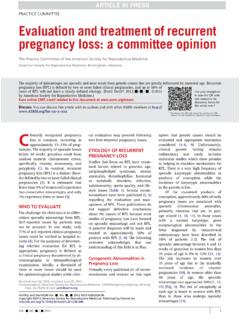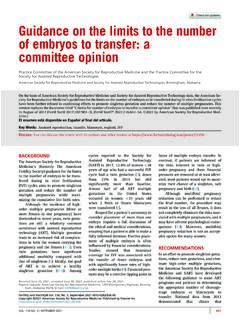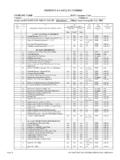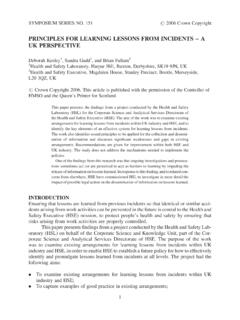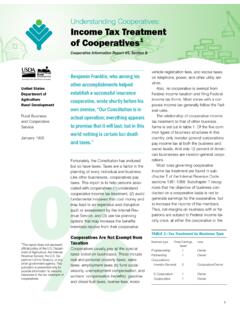Transcription of ASRM mUllerian anomalies classification 2021
1 ASRM m ullerian anomaliesclassification 2021 Samantha M. Pfeifer, , Marjan Attaran, , Jessica Goldstein, ,Steven R. Lindheim, , , John C. Petrozza, , Beth W. Rackow, ,Evan Siegelman, , Robert Troiano, , Thomas Winter, , Andrea Zuckerman, ,and Sarah D. Ramaiah, are many proposed classification systems for m ullerian anomalies . The American Fertility Society (AFS) classification from 1988has been the most recognized and utilized. The advantages of this iconic classification include its simplicity, recognizability, and cor-relation with clinical pregnancy outcomes. However, the AFS classification has been criticized for its focus primarily on uterine anom-alies, with exclusion of those of the vagina and cervix, its lack of clear diagnostic criteria, and its inability to classify complexaberrations. Despite this classification and others, the wide range of m ullerian anomalies is still largely unknown and confusing tomany providers.
2 Consequently, m ullerian anomalies may go undiagnosed for extended periods, receive inappropriate or inadequatesurgical interventions, and result in persistent issues such as pain or loss of reproductive function. The American Society for Reproduc-tive Medicine Task Force on M ullerian anomalies classification was formed and charged with designing a new classification . The TaskForce set goals for a new classification and chose to base it on the iconic AFS classification from 1988 because of its simplicity andrecognizability, while expanding and updating it to include all categories of anomalies . In addition, this was recognized as an oppor-tunity to raise awareness of this area of medicine, educate providers and learners, and promote patient advocacy. Presented here is thenew American Society for Reproductive Medicine M ullerian anomalies classification 2021. (Fertil Steril 2021;116:1238-52. 2021 byAmerican Society for Reproductive Medicine.)
3 El resumen est disponible en Espa ol alfinal del art :You can discuss this article with its authors and other readers ullerian anomalies are rare develop-mental anomalies of the female repro-ductive tract. There are manyproposed classification systems form ullerian anomalies , and the AmericanFertility Society (AFS) Classificationfrom 1988 has been the most recog-nized and utilized (1). This classifica-tion was based on the one introducedby Buttram and Gibbons in 1979 (2),which placed uterine anomalies intosimilar groups based on failure ofnormal development, resulting ingroups with similar clinical manifesta-tions, treatments, and pregnancy out-comes. In the AFS classification , anomalies are represented as simpledrawings within each group. The ad-vantages of this iconic classificationinclude its simplicity, recognizability,and correlation with clinical pregnancyoutcomes. However, the AFSclassification has been criticized forits focus primarily on uterine anoma-lies, with exclusion of those of the va-gina and cervix, its lack of cleardiagnostic criteria, and its inability toclassify complex then, other classificationshave been developed.
4 Oppelt proposedthe VCUAM classification (Vagina,Cervix, Uterus, Adnexa, and associatedMalformations), whose goal was todescribe the m ullerian and associatedanomalies accurately and precisely (3).Aci en and Aci en proposed their classi-fication categorizing m ullerian anoma-lies according to embryologic origin (4),and the European Society of HumanReproduction(ESHRE)andEmbryology-Eu ropean Society forGynaecological Endoscopy (ESGE)developed a classification based pri-marily on uterine anatomy, with cervi-cal and vaginal anomalies classified asindependent supplementary subclassesto precisely identify each anomaly (5).In addition, specific measurementcriteria using three-dimensional ultra-sound are used to define septate and bi-cornuate uterus (5).Despite the numerous classifica-tions, the wide range of m ulleriananomalies is still largely unknownand confusing, not only toobstetrician-gynecologists and therespective subspecialists, but also toproviders including radiologists, pedi-atricians, specialists in adolescentand emergency medicine, and pediat-ric general and urologic surgeons,who may encounter patients withthese anomalies .
5 This is primarilydue to the relative rarity of m ulleriananomalies and the limited exposureof these providers to patients with aReceived September 22, 2021; accepted September 22, has nothing to disclose. has nothing to disclose. has nothing to disclose. hasnothing to disclose. has nothing to disclose. has nothing to disclose. has nothingto disclose. has nothing to disclose. reports research support from Siemens Ultrasoundand speakers' bureau for GE Ultrasound and Mindray Ultrasound. reports stock ownership inJohnson & Johnson. has nothing to requests: Jessica Goldstein, , 1209 Montgomery Highway, Birmingham, AL and Sterility Vol. 116, No. 5, November 2021 0015-0282/$ 2021 American Society for Reproductive Medicine, Published by Elsevier 116 NO. 5 / NOVEMBER 2021 ASRM PAGESm ullerian anomaly during training or practice. Conse-quently, individuals may endure a delay in diagnosis forweeks, months, and even years; may undergo inappro-priate or inadequate surgical intervention(s); and mayhave persistent issues including chronic pain and/or lossof reproductive function as a need for a new classification was apparent, and the ASRMTask Force on M ullerian Anomaly classification was formedand charged with updating the AFS classification .
6 The TaskForce consisted of members of the ASRM and the Society ofReproductive Surgeons with expertise in the diagnosis andtreatment of m ullerian anomalies (Attaran, Lindheim, Pet-rozza, Pfeifer, and Rackow). Because these anomalies areoften identified in adolescents, a designated representativefrom the North American Society of Pediatric and AdolescentGynecology (NASPAG) (Zuckerman) was added to comple-ment other Task Force members who were joint members ofASRM and NASPAG (Attaran, Pfeifer, and Rackow). TheTask Force also included radiologists with expertise in bodyimaging and diagnosis of m ullerian anomalies (Siegelman,Troiano, and Winter). ASRM staff with expertise in education(Goldstein) and curriculum design (Ramaiah) were also keymembers of the Task Force. Members of the Task Force meton a regular basis monthly to weekly for development, design,and input of data into the tool, assessing functionality andincorporating Task Force was given free rein to design a new clas-sification.
7 To prepare, all existing classifications were re-viewed, and each was assessed for its advantages anddisadvantages. It was determined that an ideal classificationshould improve identification of m ullerian anomalies ,enhance communication between providers and researchers,and ultimately improve clinical care. The Task Force thenidentified the following goals to guide the development of anew classification :1 Build on the Strengths of the 1988 AmericanFertility Society classificationThe Task Force wanted the new ASRM classification to besimple, understandable, and recognizable. After muchthought and discussion, the Task Force decided to modifyand build on the old classification rather than create acompletely new model. The AFS classification has theadvantage of being simple, since it is based on clear draw-ings and is understandable, given the grouping of is also recognized as the gold standard and the most uti-lized.
8 The Task Force focused on maintaining the simplicityof the 1988 AFS classification and capitalizing on its recog-nizability. In addition, the categories were modified toinclude three additional groups: longitudinal vaginalseptum, transverse vaginal septum, and complex drawings were maintained (although updated) as effec-tive representation of the elements of the anomalies . Whilemaintaining this understandable and recognizable format,the Task Force set the goal of expanding the utility of thenew classification beyond a static reference into an educa-tional tool, which as such would be ideally suited to an inter-active Describe anomalies Involving the Uterus, Cervix,and VaginaThe Task Force recognized that only some uterine anomaliesand no cervical and vaginal anomalies were captured in theold classification . A goal was set to expand the current classi-fication to include the wide spectrum of uterine anomalies andto also include cervical and vaginal anomalies .
9 It was recog-nized that the spectrum of m ullerian anomalies represents acontinuum involving many separate, yet interrelated, ele-ments. Thus, a single classification cannot neatly and effec-tively categorize anomalies into a single group; there wasneed for overlap between categories. In addition, the currentlyrecognized anomalies do not reflect all possible m ullerian ab-normalities; undoubtedly, there remain more variations ofanomalies yet to be discovered. Therefore, the classificationshould not be considered complete, but rather should acknowl-edge that complete classification is not possible and that thereare combinations of anomalies that have yet to be seen ordescribed. Therefore, the classification should be able to incor-porate changes and additions over Standardize Terminology to SimplifyCommunication and RecognizabilityThe Task Force felt that the best way to communicate theessence of the anomalies was through descriptive example, describing an anomaly to a colleague as uterusdidelphys, duplicated cervix, with obstructed right hemiva-gina and right renal agenesis is easier to understand thanterms utilizing the ESHRE-ESGE (U3 C2 V2) or VCUAM(V5a, C1, U2, A0, MR) classification systems.
10 Recognizingthat there is often more than one way to describe the sameanomaly, the Task Force elected to list the most used termsbut to specify the preferred term. In this way, consistency interminology can be addition, defining anomalies such as septate and bi-cornuate uterus is an important function of any classificationsystem. The group wanted to establish clear definitions ofboth of these anomalies and specify how they should bemeasured. Acknowledging that not all providers have accessto all diagnostic modalities, the Task Force believed that thediagnosis should not be limited to one imaging or to correct these anomalies are not recognizedor incorporated into the Current Procedural Terminology cod-ing system. Some of the surgeries to correct these anomaliesrequire specific expertise, are often time consuming, andtherefore should only be performed in conjunction with anexperienced surgeon. By incorporating these options intothe classification , the Task Force hoped to better define Identify in Scientific DatabasesBy standardizing the nomenclature, the new classificationaimed to facilitate literature searches in the area of m ullerianVOL.


